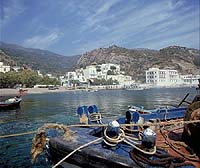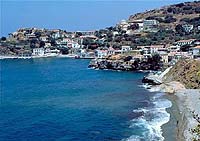Ikaria, a mountainous, thickly forested island, perpetuates the myth of Ikarus and his fall into the sea near its shores after his bold attempt to reach thesun with his waxen wings.
 In antiquity the island was called Makri (Long) and Aeoliki because of its rectangular shape, and Ichthyoessa because of its abundant fish. The south coast of the island is barren with steep cliffs, while the north is somewhat more gentle. Its scenery is wild and rugged, with the Atheras mountain range (called Pramios in antiquity) running the length of the island, furrowed by lush ravines, gorges and gullies that descend all the way to the coast.
In antiquity the island was called Makri (Long) and Aeoliki because of its rectangular shape, and Ichthyoessa because of its abundant fish. The south coast of the island is barren with steep cliffs, while the north is somewhat more gentle. Its scenery is wild and rugged, with the Atheras mountain range (called Pramios in antiquity) running the length of the island, furrowed by lush ravines, gorges and gullies that descend all the way to the coast.
Aghios Kirikos, the island’s capital and chief port, is built on a hillside, the balconies of its houses almost invisible amongst their flowers. Though small, its archaeological museum, containing Neolithic, Geometric and Roman finds, is of considerable interest.
Southwest of the capital, the first village you come to is Therma Lefkadas, where mineral springs bubble up through its sands. Beyond it, there is a string of sheltered ports and hamlets with houses made of dry stonewalls until the road ends in the wooded village of Hrissostomos.
 Returning to Aghios Kirikos and taking the road to the northeast this time, your first stop might be Therma, known since antiquity for its radioactive springs. There is little trace of the ancient settlement.
Returning to Aghios Kirikos and taking the road to the northeast this time, your first stop might be Therma, known since antiquity for its radioactive springs. There is little trace of the ancient settlement.
Continuing on in this direction, you nextcome to Evdilos, Ikaria’s second port and its former capital. The little village of Kambos, 2.5 kilometres from Evdilos, is of interest thanks to its small archaeological museum with finds from the area. It occupies the site of ancient Oinoe, (Inoi), once renowned for its grapes and, according to some myths, the first place in Greece to cultivate the vine. All that remains of it today is the ancient walls, an aqueduct and a building known as Palatia (the Palaces).
In the mountain hamlet of Kossikia, the 10th century castle of Nikaria is a typical example of Byzantine architecture. Armenistis is the next stop, a region of thick pine forest with an abundance of fresh water and a superb beach. Hristos tis Rahis, a village jutting into the open sea like a stone balcony, is also picturesque. If you continue on, don’t miss the 11th century Monastery of the Virgin of Mounte, which has frescoes and a panoramic view.
Not far from Armenistis is the miniature port of Nas, once the site of one of antiquity’s most celebrated sanctuaries dedicated to Artemis. Today nothing is left but traces of the quay and parts of the temple floor.
To visit Ikaria’s other charming villages and beaches, particularly those on the south coast, you will have to take a caique from Aghios Kirikos.
There is a yacht refuelling station at Aghios Kirikos.
 In antiquity the island was called Makri (Long) and Aeoliki because of its rectangular shape, and Ichthyoessa because of its abundant fish. The south coast of the island is barren with steep cliffs, while the north is somewhat more gentle. Its scenery is wild and rugged, with the Atheras mountain range (called Pramios in antiquity) running the length of the island, furrowed by lush ravines, gorges and gullies that descend all the way to the coast.
In antiquity the island was called Makri (Long) and Aeoliki because of its rectangular shape, and Ichthyoessa because of its abundant fish. The south coast of the island is barren with steep cliffs, while the north is somewhat more gentle. Its scenery is wild and rugged, with the Atheras mountain range (called Pramios in antiquity) running the length of the island, furrowed by lush ravines, gorges and gullies that descend all the way to the coast.Aghios Kirikos, the island’s capital and chief port, is built on a hillside, the balconies of its houses almost invisible amongst their flowers. Though small, its archaeological museum, containing Neolithic, Geometric and Roman finds, is of considerable interest.
Southwest of the capital, the first village you come to is Therma Lefkadas, where mineral springs bubble up through its sands. Beyond it, there is a string of sheltered ports and hamlets with houses made of dry stonewalls until the road ends in the wooded village of Hrissostomos.
 Returning to Aghios Kirikos and taking the road to the northeast this time, your first stop might be Therma, known since antiquity for its radioactive springs. There is little trace of the ancient settlement.
Returning to Aghios Kirikos and taking the road to the northeast this time, your first stop might be Therma, known since antiquity for its radioactive springs. There is little trace of the ancient settlement.Continuing on in this direction, you nextcome to Evdilos, Ikaria’s second port and its former capital. The little village of Kambos, 2.5 kilometres from Evdilos, is of interest thanks to its small archaeological museum with finds from the area. It occupies the site of ancient Oinoe, (Inoi), once renowned for its grapes and, according to some myths, the first place in Greece to cultivate the vine. All that remains of it today is the ancient walls, an aqueduct and a building known as Palatia (the Palaces).
In the mountain hamlet of Kossikia, the 10th century castle of Nikaria is a typical example of Byzantine architecture. Armenistis is the next stop, a region of thick pine forest with an abundance of fresh water and a superb beach. Hristos tis Rahis, a village jutting into the open sea like a stone balcony, is also picturesque. If you continue on, don’t miss the 11th century Monastery of the Virgin of Mounte, which has frescoes and a panoramic view.
Not far from Armenistis is the miniature port of Nas, once the site of one of antiquity’s most celebrated sanctuaries dedicated to Artemis. Today nothing is left but traces of the quay and parts of the temple floor.
To visit Ikaria’s other charming villages and beaches, particularly those on the south coast, you will have to take a caique from Aghios Kirikos.
There is a yacht refuelling station at Aghios Kirikos.

